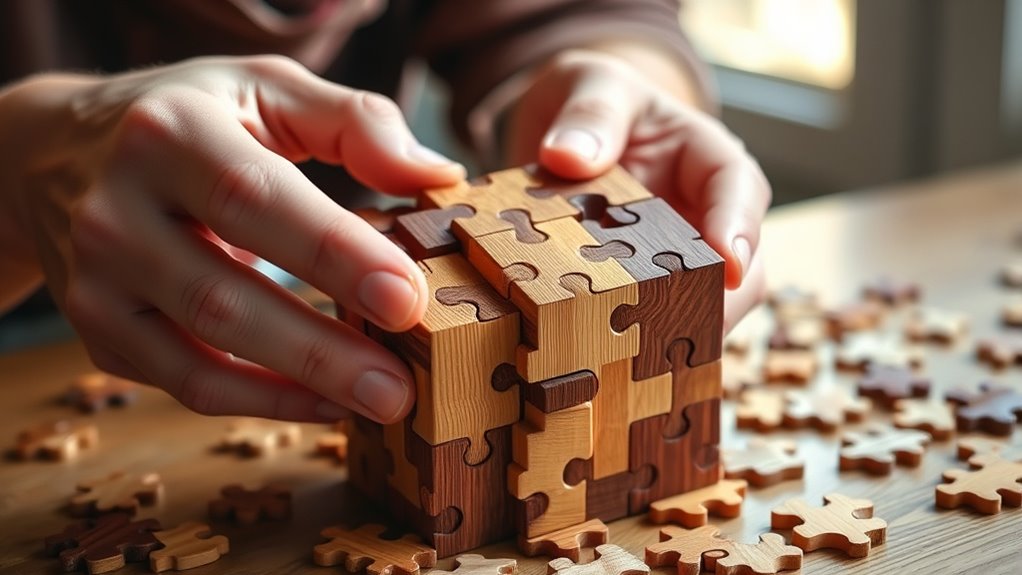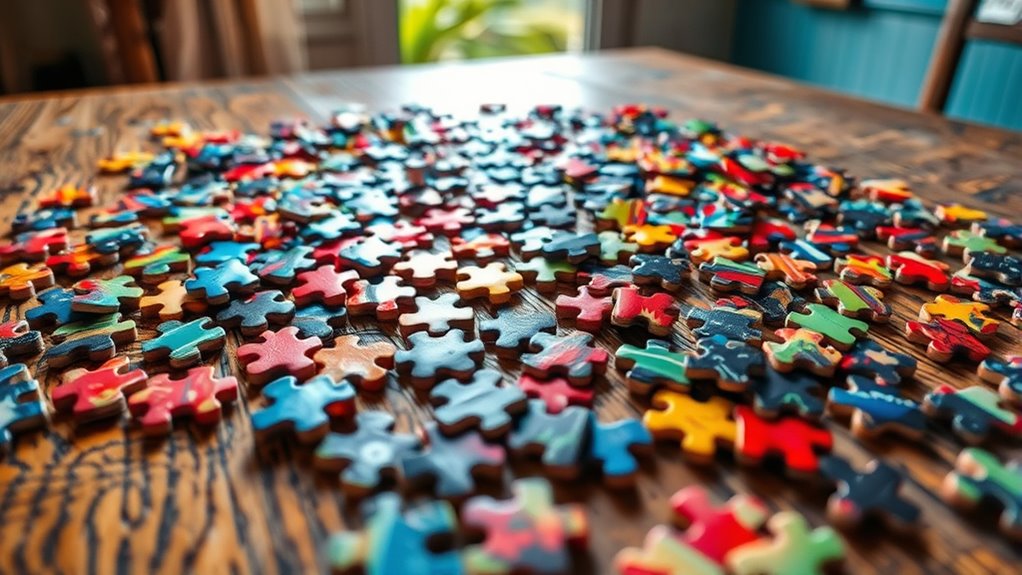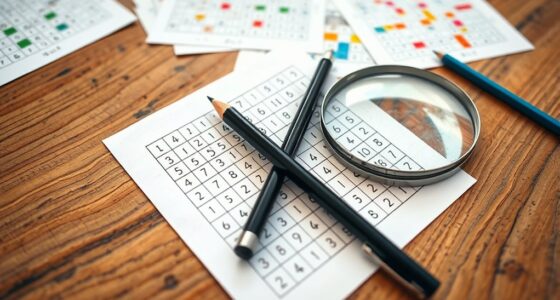Balancing puzzle difficulty involves managing cognitive load so you stay engaged without feeling overwhelmed or bored. If the puzzle is too complex, it causes frustration; if too simple, it quickly loses your interest. To find the sweet spot, focus on recognizing patterns, breaking problems into smaller parts, and developing strategies that make mental effort manageable. By understanding how your brain processes information, you can enjoy puzzles that challenge without causing frustration—keep exploring to learn more.
Key Takeaways
- Optimal puzzle difficulty balances cognitive load to challenge without causing overwhelm or boredom.
- Effective problem-solving strategies, like pattern recognition and breaking tasks into parts, reduce mental effort.
- Puzzle design should carefully manage information complexity to maintain engagement and prevent frustration.
- Recognizing and adjusting cognitive load enhances enjoyment, confidence, and sustained interest in puzzles.
- Well-balanced puzzles stimulate critical thinking while ensuring the challenge remains attainable and rewarding.

Have you ever wondered what makes a puzzle challenging or easy? It all comes down to how your brain manages information—specifically, your cognitive load—and the problem solving strategies you employ. When you approach a puzzle, your mind processes various pieces of information, trying to find patterns and connections. If the puzzle demands too much mental effort at once, your cognitive load becomes overwhelming, leading to frustration and a sense that the task is impossible. Conversely, if the puzzle is too simple, it doesn’t stimulate your thinking, and you lose interest quickly. The key is finding that sweet spot where the challenge pushes your abilities without exceeding them.
Your problem solving strategies play a crucial role in this balance. When faced with a difficult puzzle, you might instinctively break the problem into smaller parts, look for hints or familiar patterns, or try different approaches to see what works best. These strategies help manage cognitive load by reducing the amount of information you need to hold in your working memory at any given time. For example, instead of trying to solve the entire puzzle at once, you focus on one section or piece, making the task feel more manageable. Over time, as you develop effective problem solving strategies, you become better at *guiding* complex puzzles, increasing both your confidence and enjoyment.
Puzzle designers also consider cognitive load when creating challenges. They aim to craft puzzles that are just difficult enough to stimulate your brain without overwhelming it. This involves carefully balancing the amount of information and the complexity of the patterns. If a puzzle introduces too many new concepts or requires excessive mental juggling, it can tip into frustration territory. On the other hand, puzzles that are too straightforward lack the engaging quality that keeps you hooked. By understanding how your cognitive load affects problem solving, designers can create puzzles that are both fun and challenging, encouraging you to think critically while still feeling rewarded when you solve them.
Ultimately, the science behind puzzle difficulty hinges on understanding how your brain processes information and applies problem solving strategies. When you’re aware of how to manage cognitive load—breaking problems down, recognizing patterns, and choosing effective approaches—you can better *steer* challenging puzzles. This awareness not only enhances your problem solving skills but also *guarantees* that puzzles remain engaging without becoming frustrating. Recognizing the importance of problem solving strategies can significantly improve your ability to tackle complex puzzles with confidence. So next time you pick up a puzzle, think about the mental effort involved and how your strategies can make the experience more enjoyable and rewarding.
Frequently Asked Questions
How Do Cultural Differences Influence Puzzle Difficulty Perceptions?
You may find that cultural perceptions shape how you view puzzle difficulty, as different cultures often hold difficulty stereotypes. For example, some cultures see puzzle-solving as a sign of intelligence, making puzzles seem more challenging. Conversely, others might view puzzles as fun, easier activities. Your experience can vary based on these cultural influences, which affect your confidence, motivation, and perception of whether a puzzle is too hard or just right.
Can Puzzle Difficulty Be Adjusted Dynamically During Gameplay?
Think of your puzzle as a living organism that responds to your every move. Yes, difficulty can be adjusted dynamically during gameplay through adaptive difficulty and real-time calibration, fine-tuning challenges as you progress. This keeps the experience engaging, neither too easy nor too frustrating. By continuously monitoring your performance, the game adapts seamlessly, creating a personalized journey where frustration transforms into satisfaction and fun becomes a constant companion.
What Role Do Individual Cognitive Differences Play in Puzzle Frustration?
Your individual differences and cognitive variability profoundly influence how frustrated you might feel with a puzzle. If you have strong spatial skills, you may find visual puzzles easier, while those with better problem-solving strategies handle complex challenges more smoothly. Recognizing your unique cognitive profile helps you choose puzzles suited to your strengths, reducing frustration and enhancing enjoyment. Tailoring puzzles to individual differences ensures a more engaging and satisfying experience.
How Does Puzzle Difficulty Impact Brain Activity and Learning?
When you engage with challenging puzzles, your brain shows increased neural activation, especially in areas linked to problem-solving and learning. As you work through difficulty, your learning efficiency can improve because your brain forms stronger connections. However, if the puzzle’s too hard, frustration may reduce your engagement. Finding the right difficulty level optimizes neural activation and promotes effective learning, keeping you motivated and improving your skills over time.
Are There Long-Term Cognitive Benefits From Solving Challenging Puzzles?
Tackling tough puzzles can really pay off in the long run. You’ll boost your memory retention and sharpen problem-solving skills over time. These challenges help your brain stay nimble and adaptable, making complex tasks easier later on. Think of it as giving your mind a workout — the more you push, the stronger your cognitive muscles become, leading to lasting mental agility and improved overall brain health.
Conclusion
Remember, every puzzle is a dance between challenge and enjoyment. If it’s too hard, frustration takes over; if too easy, boredom sets in. Striking the right balance keeps you engaged and satisfied. As the saying goes, “The sweetest victories come after the toughest battles.” Embrace the process, learn from each stumble, and enjoy the journey of discovery. When you find that perfect difficulty, every solution feels truly rewarding—proof that patience and persistence pay off.









